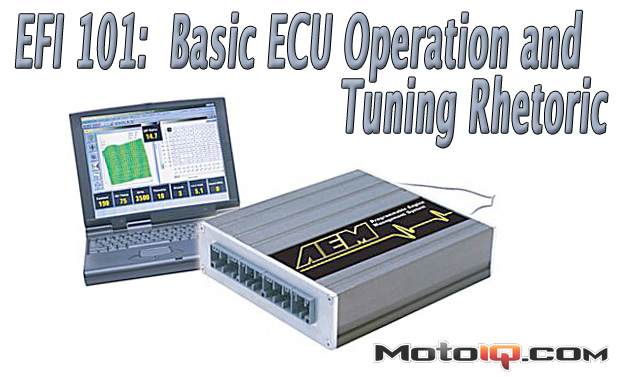,
 |
| The look up tables below are from a Cobb Access Port. |
The ECM and How It Is Calibrated to Control the Engine


All Engine Management Systems have “look-up” tables which are organized by Breakpoints. These EMS essentially take the various inputs/triggers then the ECU logic goes to the “look-up” tables you are calibrating to tell the various output devices what to do under the known conditions such as crankshaft position (CPK), intake air temperature (IAT), Mass Air Flow (MAF), RPM, coolant temperatures (ECT), etc.
Examples of Modern “Look-up” Tables found in Today’s ECMs


The above “look-up” table is a 2D version of the Primary Ignition Table for a Mitsubishi EVO 9. Notice how the X-axis breakpoints of this matrix are RPM values and the Y-axis breakpoints are calculated Load values. As you can see, the ECU is going to “look-up” what ignition advance value to use based on an RPM and Calculated Load input. This table can also be represented by a 3D version of the table as seen on the right. These two different looking tables represent the exact same data in two different formats. Either can be used for calibrating the engine.

1st) The ECM logic will “look-up” what the Boost Targets have been calibrated to; achieving these Boost Targets is the ECM’s primary goal.

2nd) The ECM logic will “look-up” what the Wastegate Duty Cycle values have been calibrated to; the ECU will then drive the boost control solenoid to achieving the desired Boost Targets.
3rd) The ECM logic will take readings from the MAP sensor and measure the Delta ? (or difference between) the desired Boost Targets and the actual measured Boost and reference that against the measured TPS and RPM.

4th) The ECM logic will “look-up” compensatory values and adjust the Wastegate Duty Cycle in order to achieve the desired Boost Targets.
I hope I was able to keep your attention throughout the article. The next article in this series will focus on understanding EFI processes through detailed EFI sub-system analysis. The animations are more detailed, but the intent is to analyze various sub-systems before we bring them all together for full engine calibration and control.



